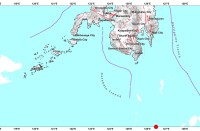Warning: Undefined array key "file" in /home/enewsph/public_html/wp-includes/media.php on line 1734
(Reuters) — Survivors continued to face enormous challenges to rebuild their lives nearly six months after super Typhoon Haiyan, one of the strongest storms to make landfall anywhere, reduced almost everything in its path to rubble when it swept ashore in the Central Philippines on November 8.
A report by the national disaster agency place the numbers of deaths at 6,300 people.
Haiyan left four million either homeless or with damaged homes.
The Southeast Asian country, estimated the total cost of a four-year reconstruction effort could surpass the current estimate of 361 billion pesos ($8 billion).
Manila has set aside funding of 54 billion pesos for the rebuilding effort from a supplemental budget passed late last year, this year’s national budget, savings, calamity and other funds. At least 80 billion pesos more would come from concessional loans offered by the World Bank,Asian Development Bank and the Japan International Cooperation Agency.
The local government said signs of recovery can be seen six months on, as roads are cleared of debris and commerce returns.
Gwendolyn Pang, spokeswoman for the Philippine Red Cross, said due to the extent of damage it was difficult to return life to normal for the residents.
“This disaster is huge, it’s really big. It affected a lot of people. The extent of damage, you can see that, it’s not easy to bring people back to the normalcy stage, or even better than before,” she said.
The Red Cross said their efforts were centered on 10 heavily affected towns and provinces in the central Philippines, including Tacloban city, which suffered the biggest damage and eastern Samar province where Haiyan made its landfall.
Pang added that permanent housing was a major concern as many of the survivors opt to rebuild their homes back in the coastal areas that had been declared as permanent danger zones by the government.
“We’re going to focus on shelter, to build permanent homes, core shelter and to repair homes. We also will focus on health to rehabilitate and reconstruct and to support the health care system in the 10 areas that we’re working at the moment,” she said.
The national government has a resettlement and rehabilitation plan to move the tens and thousands affected away from the permanent danger zones near the coastal areas frequented by storm surges and floods, but relocation has been slow.
Local media reported in late April that over 100,000 people are still living in tents in Tacloban, while close to 7,000 families are still staying at evacuation centres across the affected areas.
Foreign aid donations currently acquired by the government stood at 14 billion pesos ($336 million), with a bulk being allocated for relief distribution, humanitarian assistance and reconstruction, a report from the Philippine government website for Haiyan’s fund disbursement said.
The International Committee of the Red Cross (ICRC) estimated that a three-year recovery plan, which focuses on permanent housing and livelihood assistance, will cost around 16 billion pesos ($356 million).
Pang said with the rainy season approaching work in the region had to happen quickly.
“I think we have to move fast, and have contingency plans, especially the rainy season is about to come. How we can continue to deliver our work, so there will be no major hindrances in the full recovery effort even if other typhoon will strike,” Pang said.
Going forward, the Philippines, which is hit by an average 20 typhoons a year, is considering not only building typhoon-resilient structures but also permanent evacuation centers equipped with generators and supplies – an initiative that wasn’t part of initial plans.
The government is also considering major infrastructure projects in the central Philippines, such as relocating the coastal airport in Tacloban, the city that bore the brunt of the storm.






